| Article ID | Journal | Published Year | Pages | File Type |
|---|---|---|---|---|
| 5897692 | Cytokine | 2014 | 10 Pages |
Abstract
Subgroups of patients with breast cancer may be at greater risk for cytokine-induced changes in cognitive function after diagnosis and during treatment. The purposes of this study were to identify subgroups of patients with distinct trajectories of attentional function and evaluate for phenotypic and genotypic (i.e., cytokine gene polymorphisms) predictors of subgroup membership. Self-reported attentional function was evaluated in 397 patients with breast cancer using the Attentional Function Index before surgery and for six months after surgery (i.e., seven time points). Using growth mixture modeling, three attentional function latent classes were identified: High (41.6%), Moderate (25.4%), and Low-moderate (33.0%). Patients in the Low-moderate class were significantly younger than those in the High class, with more comorbidities and lower functional status than the other two classes. No differences were found among the classes in years of education, race/ethnicity, or other clinical characteristics. DNA was recovered from 302 patients' samples. Eighty-two single nucleotide polymorphisms among 15 candidate genes were included in the genetic association analyses. After controlling for age, comorbidities, functional status, and population stratification due to race/ethnicity, IL1R1 rs949963 remained a significant genotypic predictor of class membership in the multivariable model. Carrying the rare “A” allele (i.e., GA + AA) was associated with a twofold increase in the odds of belonging to a lower attentional function class (OR: 1.98; 95% CI: 1.18, 3.30; p = .009). Findings provide evidence of subgroups of women with breast cancer who report distinct trajectories of attentional function and of a genetic association between subgroup membership and an IL1R1 promoter polymorphism.
Keywords
SCQGMMBLRTKPSAFIBICMAFDNAdeoxyribonucleic acidinflammationAIMSAttentionCNSBreast cancercentral nervous systembody mass indexBMILinkage disequilibriumconfidence intervalminor allele frequencyGrowth mixture modelingBayesian information criterionodds ratioAncestry informative markersKarnofsky performance statusSingle nucleotide polymorphismSNPCytokine genes
Related Topics
Life Sciences
Biochemistry, Genetics and Molecular Biology
Endocrinology
Authors
John D. Merriman, Bradley E. Aouizerat, Janine K. Cataldo, Laura Dunn, Bruce A. Cooper, Claudia West, Steven M. Paul, Christina R. Baggott, Anand Dhruva, Kord Kober, Dale J. Langford, Heather Leutwyler, Christine S. Ritchie, Gary Abrams, Marylin Dodd,
